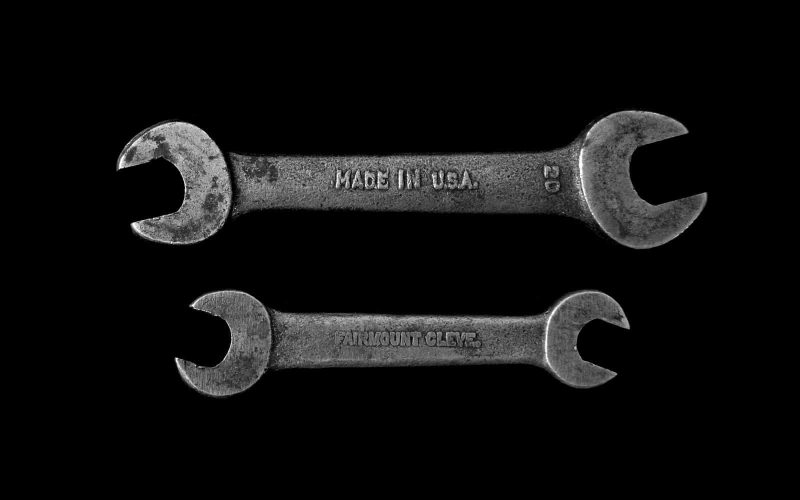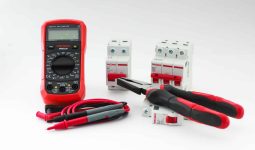In the 15th century, there were references to wrenches and uses that required them, such as pipe clamps and suits of armor.
There are different types of wrenches and spanners available in the market today.
Although it isn’t necessary to own all of them, a significant number are essential so that you can always find the right tool for the job.
A wrench, sometimes termed a spanner, is a basic hand tool used to grip and prevent the turning of rotational fasteners like nuts and bolts.
Below is a list of the different types of wrenches.
1. Open-end Wrench
These are among the simplest types of one-piece wrenches. They feature two ends of different sizes for hard-to-reach bolts.
These two U-shaped ends can be used with various bolts in metric or imperial measurements, generally of different sizes.
They are angle-orientated and may easily suit the target perpendicularly and horizontally.
Sometimes, this wonderful tool is the sole answer for loosening or tightening a bolt.
There’s another open-end wrench type with only one U-shaped jaw of a specified width.
Open-end wrenches are light and suitable for small operations. They’re available in numerous sizes and are frequently bought in sets or kits of every size.
2. Torque Wrench
To avoid overtightening, this socket wrench has been engineered to produce precise torque.
This amount may be adjusted, and there are various options (including manual, digital, and other variations).
It’s the most frequent tool for automotive repairs, such as tightening lug nuts. Torque sticks may be better in terms of speed, but they’re not as precise.
Torque wrenches can also tighten nuts and bolts on bicycles, farming equipment, and other items when the manufacturer specifies a precise torque requirement.
3. Tension Wrench
In lockpicking, a tension wrench is one of those wrenches you’ve seen but never heard of, and it may be found in a variety of designs.
While the pick is operating, tension is applied using these tools, which might be stiff or flexible.
Since the tension wrench remains stationary while the other tool is moved, you may be puzzled about how someone picked a lock without using both.
4. Crescent Wrench
Another name for this type of wrench is “adjustable wrench.” They’re quite popular since they’re more convenient to use and don’t require a separate tool for each size bolt.
Since they’re so versatile, they may be found in almost every garage. They have a spiral screw that moves the jaw. Several tasks would normally require regular wrenches.
However, crescent wrenches are one of the thicker types of wrenches and can handle several of them.
Considering this reason, it has become the most often used wrench in the modern world.
Due to their adaptability, they’re employed for various repairs and completions.
It was designed specifically for usage in small places. That being stated, they should be handled with caution since excessive force will flatten the bolt’s surface.
5. Dog Bone Wrench
Both ends of the dog bone wrench have a different socket size. This wrench’s bone-shaped look, frequently referred to as the dumbbell wrench, has given it its name.
Despite their ability to squeeze in tight areas, they are solely used for bike maintenance.
To allow for more flexibility, certain dog bone wrenches have swivel heads.
6. Allen Wrench
Knowing that Allen wrenches are a specific type of key wrench, it should be easy to deduce their design.
Hexagonal sockets with uneven arms make up this type of wrench. Their head is designed to drive screws into the target fittings.
Because of its shape, it is also known as a hex key or Allen key. Keys are usually supplied in sets that include all of the sizes and head shapes that you may require.
Like other types of wrenches, Allen wrenches are used in constructing a wide range of household appliances and electrical devices.
In addition, the six-edged bolts on this tool are used to repair bicycles. It’s just an L-shaped rod that you can keep just about anywhere.
7. Ratchet Wrench
To turn nuts and bolts, a ratchet wrench does not need a wrench to be lifted out of its socket.
A lever or mechanism in the end sections allows the end to ratchet or turn the fastener in one direction but not the other when a wrench handle is returned.
A ratchet wrench allows you to tighten or loosen a nut or bolt without removing the wrench from the nut or bolt.
8. Fixed Wrench
Fixed wrenches are easy to obtain and available in a wide range of sizes. They have a closed loop on one side and an open loop on the other.
Even though they have a simple shape, they are used to fasten extremely tough bolts.
Screws with square and hexagonal square shapes can be driven with a closed loop.
They remove most of the frustration of the wrench slipping off the bolt head and can hold a wider range of bolt head designs more securely.
The design of fixed wrenches is known for its efficiency. It’s also possible for them to unlock those tough bolts you’ve been unable to open.
Small and light, fixed wrenches are ideal for squeezing into tiny spaces. Combination wrenches are another name for these types of wrenches.
9. Crowfoot Wrench
They do not have cylindrical socket heads but rather appear more like open-end or box-end wrenches. They use the same drive sizes as socket wrenches.
When measuring the torque required to turn or loosen a fastener or using a standard socket wrench is not an option, these tools come in handy.
Open-end and box-end wrenches are more expensive; thus, many choose the smaller, less expensive crowfoot wrenches instead of bigger, more expensive tools.
Due to their size and weight, they are also useful in other situations.
10. Box Ended Wrench
Unlike the previous types of wrenches, this one is more closely connected. Wrenches with box ends have a flat shaft with loops closed on both ends.
Consequently, the bolts may be tightened or loosened more easily. Because of their different shapes, the loops can be slipped over various bolts.
Often, the ends of the handle are elevated or angled, making them stronger and easy to use.
The box-ended wrench has the benefit of not rounding the edges of the nuts it operates on. Wrenches like this are perfect for every toolbox.
11. Oil Filter Wrench
Oil filter wrenches are a common automotive tool. They come in four different forms and frequently need to be matched to a vehicle’s brand.
Chains and metal straps wrap around filter cases, and a claw wrench tightens or loosens the filter’s threaded end.
Finally, socket-style filter wrenches resemble a cup with the sides cut away. They are used to tighten and loosen filters.
Combined with a ratchet handle, they attach to the bottom of a filter cap.
12. Pipe Wrench
They are referred to as such because they are designed to operate with pipe fittings.
Since they’re built for metal pipe assembly and disassembly, plumbers are the primary users of these tools.
A pipe wrench can slide on and off a pipe fitting. Compared to other types of wrenches used for everyday tasks, these are heavier and more robust.
An adjustable wrench and a pipe wrench are both types of wrenches. However, adjustable wrenches are more prone to scraping the pipe’s surface, which isn’t a big deal.
The jaws of a pipe wrench are toothed and may move upwards and downwards in an F-shape.
Despite the rough handling, this instrument is essential to every homeowner’s toolkit.
13. Bionic Adjustable Wrench
Loggerhead Tools’ bionic adjustable wrench is one of the best different types of wrenches.
Squeezing it like pliers makes the box-end jaw compress to suit up to sixteen different nut and bolt sizes.
The fastener will fit exactly, and using this tool will not damage or strip your nuts and bolts.
Despite its tiny size, this wrench is perfect for loosening or tightening visible fasteners, as long as you have enough area to grasp, squeeze, and turn the wrench with both hands.
14. Spoke Wrench
These tiny wrenches are designed for maintaining wire wheel spokes.
They feature a slot on one end that goes around a spoke and a drive head on the other end that goes around the nipple.
This wrench may be turned a full circle without needing to be removed. Bike shops are the best place to find this tool.
A small open-ended wrench may resemble some varieties, while others may appear more like a curved, flat piece of metal.








